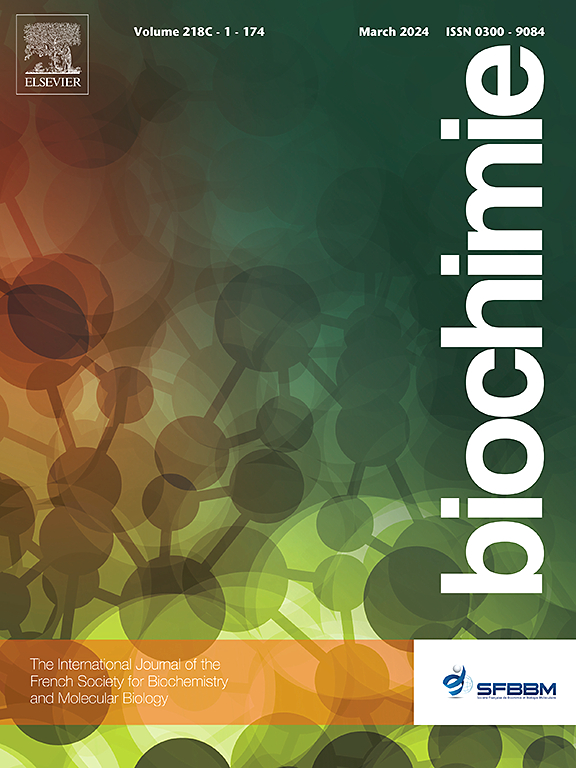Bothropstoxins I and II as potent phospholipase A2 molecules from Bothrops jararacussu to impair hepatitis C virus infection
IF 3
3区 生物学
Q2 BIOCHEMISTRY & MOLECULAR BIOLOGY
引用次数: 0
Abstract
Hepatitis C virus (HCV) (now classified Hepacivirus hominis) that infects an estimated 50 million individuals worldwide and causes chronic liver disease. The current treatment for infected patients primarily relies on direct-acting antivirals (DAAs). However, this treatment is marked by its high cost, numerous side effects, and documented instances of antiviral resistance. These challenges underscore the imperative for developing novel therapeutic strategies. In this framework, naturally occurring compounds have exhibited considerable medical significance attributable to their biological functionalities. Compounds extracted from snake venoms have evidenced antiviral efficacy against a variety of viral pathogens including Orthoflavivirus denguei (DENV), Orthoflavivirus flavi (YFV), Orthoflavivirus zikaense (ZIKV), and HCV. Here, the activity of 10 proteins isolated from snakes’ venom of Bothrops genus were evaluated against HCV replicative cycle. JFH-1 HCV system infected Huh-7.5 cell. Cell viability was measured simultaneously through MTT assay. Eight compounds inhibited up to 99 % of HCV infection, with the most potent inhibitory rates observed in BthTX-I and BthTX-II. These exhibited an SI of > 50 and 16,220, respectively, being able to block 84.7 % and 96 % of HCV infectivity. BthTX-II also demonstrated a protective effect in cells treated prior to HCV infection of approximately 86.7 %. Molecular docking calculations suggest interactions between the two proteins with HCV E1E2 glycoprotein complex. BthTX-II exhibited stronger interactions, indicated by 22 hydrophobic interactions. In conclusion, these compounds were shown to inhibit HCV infectivity by either acting on the virus particles or protecting the cells against infection.

Bothropstoxins I和II是抑制丙型肝炎病毒感染的有效磷脂酶A2分子。
丙型肝炎是一种由人肝病毒(丙型肝炎病毒,HCV)引起的肝脏疾病,估计目前全球约有1.7亿人受到影响。目前对感染患者的治疗主要依赖于直接作用抗病毒药物(DAAs)。然而,这种治疗的特点是成本高,副作用多,并且有记录的抗病毒药物耐药性实例。这些挑战强调了开发新的治疗策略的必要性。在这个框架下,天然存在的化合物由于其生物功能而表现出相当大的医学意义。从蛇毒中提取的化合物已被证明对多种病毒病原体具有抗病毒作用,包括登革正黄病毒(DENV)、黄正黄病毒(YFV)、寨卡正黄病毒(ZIKV)和丙型肝炎病毒。本研究从Bothrops属蛇毒中分离的10种蛋白对HCV复制周期的活性进行了评价。采用全长JFH-1 HCV系统感染Huh-7.5细胞。同时用MTT法测定细胞活力。8种化合物抑制高达99%的HCV感染,在BthTX-I和BthTX-II中观察到的抑制率最高,分别为13.5和1736,能够阻断84.7%和96%的HCV感染,顺序相同。BthTX-II在HCV感染前治疗的细胞中也显示出约86.7%的保护作用。分子对接计算表明这两种蛋白与HCV E1-E2糖蛋白复合物之间存在相互作用。BthTX-II表现出较强的相互作用,有22种疏水相互作用。总之,这些化合物被证明通过作用于病毒颗粒或保护细胞免受感染来抑制HCV的感染性。
本文章由计算机程序翻译,如有差异,请以英文原文为准。
求助全文
约1分钟内获得全文
求助全文
来源期刊

Biochimie
生物-生化与分子生物学
CiteScore
7.20
自引率
2.60%
发文量
219
审稿时长
40 days
期刊介绍:
Biochimie publishes original research articles, short communications, review articles, graphical reviews, mini-reviews, and hypotheses in the broad areas of biology, including biochemistry, enzymology, molecular and cell biology, metabolic regulation, genetics, immunology, microbiology, structural biology, genomics, proteomics, and molecular mechanisms of disease. Biochimie publishes exclusively in English.
Articles are subject to peer review, and must satisfy the requirements of originality, high scientific integrity and general interest to a broad range of readers. Submissions that are judged to be of sound scientific and technical quality but do not fully satisfy the requirements for publication in Biochimie may benefit from a transfer service to a more suitable journal within the same subject area.
 求助内容:
求助内容: 应助结果提醒方式:
应助结果提醒方式:


